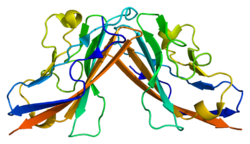Coxsackievirus and adenovirus receptor (CAR) is a protein that in humans is encoded by the CXADR gene.[5][6][7] The protein encoded by this gene is a type I membrane receptor for group B coxsackie viruses and subgroup C adenoviruses. CAR protein is expressed in several tissues, including heart, brain, and, more generally, epithelial and endothelial cells. In cardiac muscle, CAR is localized to intercalated disc structures, which electrically and mechanically couple adjacent cardiomyocytes. CAR plays an important role in the pathogenesis of myocarditis, dilated cardiomyopathy, and in arrhythmia susceptibility following myocardial infarction or myocardial ischemia. In addition, an isoform of CAR (CAR-SIV) has been recently identified in the cytoplasm of pancreatic beta cells. It's been suggested that CAR-SIV resides in the insulin secreting granules and might be involved in the virus infection of these cells.[8]
- ^ a b c GRCh38: Ensembl release 89: ENSG00000154639 – Ensembl, May 2017
- ^ a b c GRCm38: Ensembl release 89: ENSMUSG00000022865 – Ensembl, May 2017
- ^ "Human PubMed Reference:". National Center for Biotechnology Information, U.S. National Library of Medicine.
- ^ "Mouse PubMed Reference:". National Center for Biotechnology Information, U.S. National Library of Medicine.
- ^ Bergelson JM, Cunningham JA, Droguett G, Kurt-Jones EA, Krithivas A, Hong JS, Horwitz MS, Crowell RL, Finberg RW (Feb 1997). "Isolation of a common receptor for Coxsackie B viruses and adenoviruses 2 and 5". Science. 275 (5304): 1320–3. doi:10.1126/science.275.5304.1320. PMID 9036860. S2CID 33824689.
- ^ Tomko RP, Xu R, Philipson L (Apr 1997). "HCAR and MCAR: the human and mouse cellular receptors for subgroup C adenoviruses and group B coxsackieviruses". Proceedings of the National Academy of Sciences of the United States of America. 94 (7): 3352–6. Bibcode:1997PNAS...94.3352T. doi:10.1073/pnas.94.7.3352. PMC 20373. PMID 9096397.
- ^ "Entrez Gene: CXADR coxsackie virus and adenovirus receptor".
- ^ Ifie, Eseoghene; Russell, Mark A.; Dhayal, Shalinee; Leete, Pia; Sebastiani, Guido; Nigi, Laura; Dotta, Francesco; Marjomäki, Varpu; Eizirik, Decio L.; Morgan, Noel G.; Richardson, Sarah J. (November 2018). "Unexpected subcellular distribution of a specific isoform of the Coxsackie and adenovirus receptor, CAR-SIV, in human pancreatic beta cells". Diabetologia. 61 (11): 2344–2355. doi:10.1007/s00125-018-4704-1. ISSN 1432-0428. PMC 6182664. PMID 30074059.





